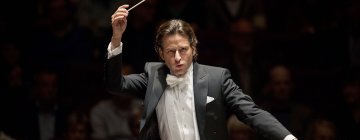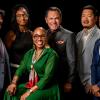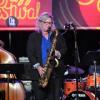Sprawling across two-and-a-half days and 22 bucolic acres, the Monterey Jazz Festival contains a multitude of storylines.
For starters, the world’s longest continuously running jazz event, which returns to the Monterey County Fairgrounds Sept. 26–28 for its 68th season, seems to be at a crossroads. Behind the scenes, an unexpected change in leadership quietly saw the exit of composer Darin Atwater after a single season.
An outsider with no previous relationship to the festival, he was only the third artistic director since Monterey Jazz’s founding, and his 2023 appointment was widely hailed as an era-defining move. It didn’t turn out that way. But neither the festival’s board nor Atwater has made a statement about what went wrong.
The festival plans to announce the new artistic team this weekend, according to Executive Director Bobbie Young. The program was mostly booked by Bruce Labadie, an experienced arts programmer who has helmed venues such as Villa Montalvo, the Mountain Winery, and, since its founding in 1990, San Jose Jazz’s Summer Fest. Stepping in relatively late in the game as an interim programmer, Labadie recalled a phone call on a Friday in December 2024 asking him to come in that Monday.
“When I arrived, they said, ‘here’s your contract,’” he said.
The most conspicuous change is that Labadie has leaned into jazz’s deep roster of vocal talent. From well-established stars Dianne Reeves, Carmen Lundy, and René Marie to a brilliant contingent of rising twentysomethings like Tyreek McDole, Lucía, and Ekep Nkwelle, singers dominate the program. But the most interesting thread running through the weekend is the profusion of Cuban talent, a thematic filament that connects Monterey Jazz to its larger neighbor to the north, SFJAZZ.
The festival’s Cuban theme amplifies but doesn’t duplicate the SFJAZZ Center’s “Rumba y SFJAZZ” program Sept. 25–28, which is built around legendary reed player Paquito D’Rivera. He’s not performing at Monterey, but most of the other artists are, starting with the pianistic double bill pairing Alfredo Rodríguez and Dayramir González Sept. 27.
On the fairgrounds, the Cuban artists perform separately at the 300-seat Pacific Jazz Café Presented by SFAZZ, an unprecedented collaboration between the organizations. It’s the festival’s most intimate venue, and it’s where the bulk of the keyboard action takes place, with singular pianists such as Benny Green, Sullivan Fortner, and Christian Sands (who’s back in California for a project with vocalist Kurt Elling on Oct. 4 at SFJAZZ and Oct. 5 at Bach Dancing & Dynamite Society) performing. The Alfredo Rodriguez Trio with Cuban drummer Michael Olivera and versatile Ukrainian bassist Han Beyli fits right into that rubric, while also kicking off Monterey’s Cuban programming Sept. 26.
González follows Rodríguez on Sunday in Pacific Jazz Café after their SFJAZZ double bill, which marks the first time the two contemporaries have shared a stage. They both hit the North American scene around the same time and were hailed as the future of Cuba’s illustrious piano jazz lineage, but their paths were hardly parallel.
“We come from the same musical school of piano, but we’re coming from different social and economic backgrounds,” said González, 41, who also performs with his quartet at Kuumbwa Jazz Center Sept. 25. “I’m a Black man from the hood; he’s the son of a very well-known singer. I had access to the same training that he got, but where you see the difference is that our diverse backgrounds have led to different opportunities and career trajectories."
Famously discovered by Quincy Jones at the Montreux Jazz Festival in 2006, Rodríguez flourished under the wing of the legendary producer, developing a populist approach that put his dazzling technique in the service of richly textured instrumentation. González was a protégé of Chucho Valdés, and his climb to international recognition has been more deliberate than Rodríguez. While his music is rooted in Afro-Cuban rhythms, González has embraced a global palette.
Like on his upcoming album V.I.D.A, his quartet features Uruguayan electric bassist Jose Ignacio Mateu Graside, Argentine-born drummer Juan Chiavassa, and Japanese percussionist Taka Nikaido, who’s also worked with Paquito D’Rivera and Terence Blanchard. Nikaido has been immersed in Cuban music since his early teens, including a trip to Cuba to study with storied rumba ensemble Los Muñequitos de Matanzas.
González said he realized that working with non-Cuban musicians “opened up the sound.”
“[After] bringing musicians in from other cultures that appreciate Cuban music, my compositions could open up,” he said. “Feeling the 6/8 pulse on bass from a Black dude from Brooklyn who grew up playing in church gave me a wider sound.”
Cuban violinist, vocalist, and keyboardist Yilian Cañizares might be the biggest discovery at both SFJAZZ, where she plays fours shows at the Joe Henderson Lab with her trio Sept. 25-26, and at Monterey Jazz Festival Sept. 27 at the Pacific Jazz Café. A longtime Swiss resident still relatively unknown in North America, she toured with pianist Omar Sosa before the pandemic and has only started making inroads with her own music. Her guest appearance with John Santos in July was one of the highlights of the Stanford Jazz Festival.
Rounding out the Cuban contingent is Jorge Luis Pacheco, another spectacular pianist from Havana. Presenting a tribute to the Buena Vista Social Club, he brings his trio with bassist Gerson Lazo-Quiroga and drummer Reinier Mendoza to San Jose Jazz’s Break Room on Sept. 27, and Monterey’s Pacific Jazz Café on Sept. 28. González used to study with Pacheco’s sister, “and his mom is a great singer,” he said. “Luis and I have hung out many times.”
Last year, González presented Pacheco at the Havana Jazz Festival in a two-piano showcase, “The Art of Cuban Piano,” which featured “players I admire from around the world,” he said. In the past few years, he’s shared the festival stage with pianists Adam Goldberg and Emmet Cohen, and he said he’ll be presenting Christian Sands in January.
“The idea is to bring to my country these amazing voices,” he said. “It’s a way for me to stretch, [and] to not get too comfortable on my own. You have to be aware of their sound, be flexible, [and] be a team player. We create the seed, and the idea is maybe [to] make an album.”
With the collaboration between Monterey Jazz and SFJAZZ taking root, González’s side project is a seed within a seed. The former offers a fertile field for new collaborations to germinate.




